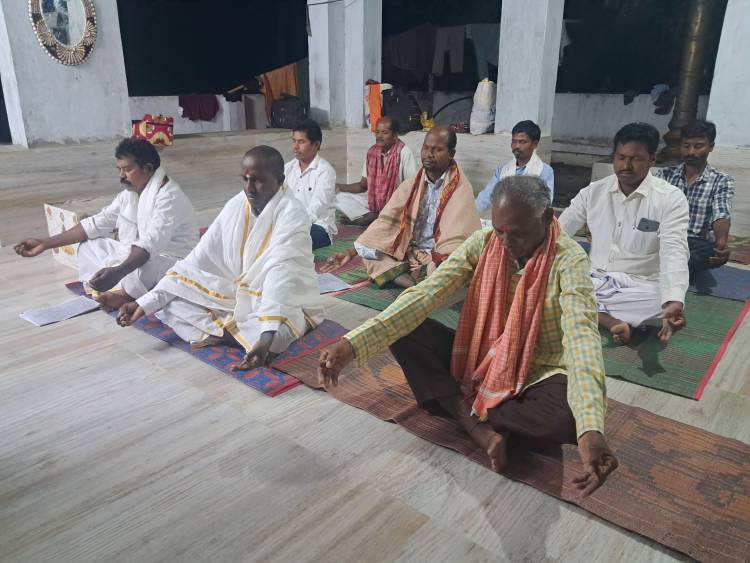[GHHF] Day Four of ST Archaka Training: In-depth Explanation of Temple Puja Procedures, Practical Skill Practice, and Community Engagement
 Kambalapalem Village, Alluri Sitarama Raju District: The five-day Archaka training program for Scheduled Tribe (ST) youth, organized by the Global Hindu Heritage Foundation (GHHF) in Kambalapalem village, Alluri Sitarama Raju district, has reached its fourth day. Today's training significantly emphasized practical experience alongside theoretical knowledge, with a strong focus on community participation.
Kambalapalem Village, Alluri Sitarama Raju District: The five-day Archaka training program for Scheduled Tribe (ST) youth, organized by the Global Hindu Heritage Foundation (GHHF) in Kambalapalem village, Alluri Sitarama Raju district, has reached its fourth day. Today's training significantly emphasized practical experience alongside theoretical knowledge, with a strong focus on community participation.
The participants, as usual, woke up before sunrise and began their day with meditation. After tiffin, they attended the training sessions. In the morning session, the trainer, Shri Krishnareddy Garu, provided an in-depth explanation on how to perform Pujas in various temples. He detailed the subtle differences in Puja procedures for each deity and temple, the rules to be followed, and the significance of mantras. He emphasized the importance of discipline, cleanliness, and devotion in performing Puja. Special attention was given to the methods of performing Pujas in small temples or village deity temples in rural areas, which is crucial for Archakas from agency regions.
Additionally, the significance and procedure of Kalasha Puja were thoroughly explained. Participants learned about the importance of various Puja Dravyas (sacred offerings) and their role in different rituals. The use of specific Pattras (sacred leaves) in worship was also detailed, with trainers explaining their spiritual significance and applications. Examples of such commonly used leaves include Tulasi (Holy Basil), Bilva (Bael), Durva (Bermuda grass), and Mango leaves, each revered for their unique properties and association with deities. They also delved into the purpose and usage of important ritual items like the Kalasham (pot/vessel) and Panchapatra (a set of five small vessels). They explained how the Kalasham symbolizes deities, creation, and prosperity, while the Panchapatra (typically consisting of a small cup and a spoon (uddharani)) is vital for purification rituals like Aachamanam (sipping holy water) and offering water during various ceremonies.
The importance of the Ghanta (bell) used in Puja was also explained, detailing how its sound is believed to invite positive energy and ward off negative forces. Furthermore, the significance of Harati (waving of lamps) offered to the deity after Puja was taught, illustrating how it allows devotees to witness the divine radiance and receive blessings.
After lunch in the afternoon, the theoretical concepts learned so far were put into practical application. Participants directly practiced elements such as Shodashopacharas, prayer slokas, the method of reciting Sankalpam, Kalasha Puja, the use of Puja Dravyas, ringing the Ghanta, and offering Harati. The trainers personally guided each individual, clarified their doubts, corrected minor errors in Puja performance, and instilled confidence in them. This helped in developing practical skills essential for true priesthood, going beyond mere bookish knowledge.
The evening Bhajan session was particularly vibrant and successful, with local villagers enthusiastically participating, creating a truly devotional and unifying atmosphere within the community.
GHHF is offering this training program completely free of cost. GHHF is also covering the participants' meals, accommodation, and travel expenses. Through this program, GHHF is not only training ST youth from agency areas in priesthood but also instilling religious awareness in them and preparing them to resist religious conversions.
Your donations are appreciated:
By Zelle: ghhfusaorg@gmail.com
PayPal: savetemples.org
By Check: Or you can send a check payable to GHHF, 14726 Harmony Lane, Frisco, TX 75035.
It is tax-deductible.
By Rupees: call 601-918-7111; +91 83096 43979




















 Urgent support needed for Bangladesh Hindus
Urgent support needed for Bangladesh Hindus 







